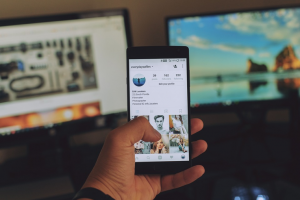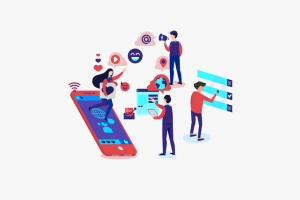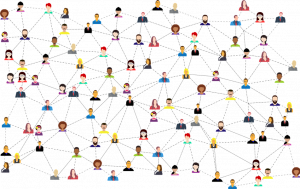30 Social Media Overview
Michaela Taylor
30.1 Introduction
Keywords
- Social media – the forms of electronic communication (such as websites for social networking and microblogging) through which users create online communities to share information, ideas, personal messages, and other content (such as videos) (Webster, 2021)
- Communication technology – refers to all the tools used to send, receive, and process information. In today’s fast climate, efficiency and convenience are the keys to successful communication technology (Novak, 2019).
- Employee recruitment – organizational actions that are intended to (a) bring a job opening to the attention of potential job candidates; (b) influence whether these individuals apply for the opening; (c) affect whether recruits maintain interest in the position until a job offer is extended; and (d) influence whether a job offer is accepted and the person joins the organization (Hodgkinson & Ford, 2008).
Learning Objectives
By the end of this chapter, students should be able to:
- Understand what social media is and the impact it has had on society in the aspects of business marketing, employee recruiting, and mental health.
- Describe the role of social media in the past decade and its impact on the growth and development of society.
- Identify aspects of social media as a base knowledge for future chapters’ discussions.
- Discuss the vast possibilities social media holds when looking into future data collection.
Social media is a technology mainly of the current generation and will continue to grow generation after generation. In the past couple of decades, social media has developed immensely into a technology that serves more purposes than the creators could have ever imagined. The initial intent of social media was to make communication and connection accessible from a distance and has developed into a technology that serves endless other purposes.
Although social media is a vastly helpful technology, there are also many downfalls to social media. Social media can be intentionally used in harmful ways to hurt others, but at the same time, some of the adverse effects of social media are unintentional. Many of the addictive behaviors towards social media have begun to cause many problems throughout society (Keles, 2019). As you read through this chapter, you will see the progression of social media and some of the impacts it has had on society and the world. You will also be introduced to a future outlook on social media and its possible further development in the near future.

“Mobile Phone Social Media” by Erik Lucatero is under a Pixabay License.
30.2 What is Social Media?
Key Takeaway
As defined by the Webster dictionary, social media are forms of electronic communication, such as websites for social networking and microblogging, through which users create online communities to share information, ideas, personal messages, and other content (2021). This definition is a very broad and open-ended definition of social media. Social media is a constantly changing and growing technology. It can take the form of many different definitions depending on who is using the sites and how they are using them. The basics of social media are that it is web-based and allows individuals to (1) construct a public or semi-public profile within a bounded system, (2) create and visualize a list of other users with whom they share a connection, and (3) view and navigate their list of connections and those made by others within the social media site (Wolf et al., 2018). Although these are the main aspects of defining social media, because of the vastness of this technology, it is hard to include all abilities of social media sites in a single unchanging definition.
As most users know it, social media serves as a pathway for individuals to connect with others they know and meet with those they don’t. Although the primary usage of social media sites is to make connections, they also have developed many other purposes. For example, a study shows that the most popular activities in using social media sites are entertainment, arts, politics, sports, and other (Hamade, 2013). As you can see, social media is a platform that can be what the user makes of it. In all, social media is a technology that is changing continuously and integrating into the lives of most people.
30.3 History of Social Media
Key Takeaway

“Letters in Morse Code” by User F1jmm is licensed under CC BY-SA 4.0.
Social media dates back to 1844 with the creation of the Morse Code, which is a series of electronic dots and dashes tapped out by hand on a telegraph (Maryville, 2021). This code allowed people to connect and share information even if they were far apart, which is a significant foundation of social media today. Skipping forward nearly a century in 1969, the Advanced Research Projects Agency Network was formed and led to the birth of email. Later in 1987, a more nationwide digital network known as NSFNET was formed, and in 1997, the first social media platform, Six Degrees profile uploading service, was launched (Maryville, 2021). Soon, in 2002, Friendster was created, and for the first time, the possible harmfulness of free social media platforms was illustrated through fake profiles and considerable technical difficulties (Boyd & Ellison, 2007). In the early years, social media was trying to simply enable more accessible communication from a distance and ended up birthing a new era of communication technologies.
In 2002, LinkedIn was founded as a social media for professionals (Maryville, 2021). Next, in 2003 Myspace was born to attract users from Friendster, which had announced it would be moving to a fee-based membership. This gave Myspace the ability to gain popularity and grow its user base very quickly. Myspace eventually met its demise because of safety issues that were plaguing the site (Boyd & Ellison, 2007). In 2004, Mark Zuckerberg founded Facebook, and this social media site grew to replace the spot of Myspace. Following closely behind Facebook, Reddit, Twitter, Instagram, Pinterest, Snapchat, and most recently, TikTok came to be (Maryville, 2021). Social media’s birth was slow-moving, but once the ideas and values of social media sites gained traction, the number of sites exploded and grew very quickly just in the past decade. Social media has ingrained itself into the everyday lives of most individuals who have mobile devices and computers.
30.4 Impacts of Social Media on Society
Key Takeaway
Because of the intense integration of social media into our society over the years, there are, in turn, many effects on the world as a whole. Social media has changed the way people communicate and connect in some ways for the better, and in others, some may say, for the worse. The impacts of social media are vast and ever-growing. Still, the main ones we will focus on in this section of the textbook are the impacts on business through social media marketing, employee recruitment, and mental health.

“Social Media Marketing” by Joseph Mucira is under a Pixabay License.
To begin, the creation and development of social media has changed the business world. Social media is a platform that stimulates two-way communication between a business, its consumers, and its stockholders (Akram & Kumar, 2018). Through these platforms, companies have found a new, more personalized way to advertise to consumers, and consumers have found a new, more personalized way to give feedback and express their needs. Although there are many positive effects of social media on business, there are risks that come with the freedom of social media within a business. Implementing social media marketing into a business can be costly and take a lot of time and attention (Siddiqui & Singh, 2018). Businesses have changed how they conduct their day-to-day activities because of social media marketing and will continue to adjust as social media grows and further develops.
To go along with the impacts on business, social media has dramatically impacted the employee recruitment process. As most of you have probably experienced, the development of LinkedIn, university-created recruitment sites, such as Clemson’s own JobLink, and many others, has made the employee recruitment process much more convenient. Organizations worldwide use social media sites to reach out to potentially qualified candidates based on detailed profiles (Lal & Aggarwal, 2013). Additionally, communicating with these candidates has become much more feasible as the candidates are just a message, phone call, or video call away. Although there are many other positives to social media in the recruitment process, there are also many potential negatives. There is an enormous inadequacy of information because the only information provided is provided by the creator of the profile (Lal & Aggarwal, 2013). Some people also have challenges depicting what to share and what not to share, leading to some unforeseen consequences. Despite these positive and negative aspects, one thing is for sure: social media’s creation has vastly changed the way employers recruit.
Finally, we will venture into the effects of social media on mental health. Social media is a way for people to connect, and many times that is what it is used for. These connections with distant relatives, friends, and other loved ones have many positive effects, but there is also a price in exchange for the use of social media to connect in the world. Studies have shown that social media use correlates to mental health suffering (Bashir & Bhat, 2017). Social media users have unlimited access to what people are posting on these sites, and this unlimited access is to the good parts of social media and the bad parts. There are many outcomes, positive and negative, of social media. Still, it seems that the bad recently has outweighed the good, leading to an influx of mental disorders in the people who interact with social media sites (Bashir & Bhat, 2017).
As you can see, there are many ways social media affects our world and the society around us. Because of the constant change of social media, we cannot say what all the effects will be, but the topics mentioned above are the most widely known and spoken on aspects. Further exploration into these topics will be discussed in later chapters of this section.
30.5 Future Outlook of Social Media
Key Takeaway
Looking towards the future, social media will continue to reshape our world as we know it in many differing aspects. Social media has continuously grown over the past decade in the US. This growth will more than likely continue but at a slower rate, as 72% of Americans are already present on at least one social media platform (Pew Research, 2021). It appears the use of social media is plateauing, so the growth of social media in the future will be focused on the impacts on its current users and the growing uses for social media sites.

“Social Media Connections” by Gordon Johnson is under a Pixabay License.
Because of the massive and growing number of social media users, these sites hold a plethora of information. Social media has become a significant source of data for many different kinds of information for businesses, the government, individuals, researchers, and others. This data can provide important insights that can help our society grow and develop further. Although this data collection could be positive, there are some possible negative outcomes. With any data collection, there needs to be lines drawn as to where data collection becomes unethical (Humphreys, 2013). The possibilities social media creates are endless, but we have to be cautious about keeping the use ethical and morally sound.
Josh, a current senior at Clemson University, began his quest for a job after graduation in 2021. Previously, as a sophomore, he experienced the job recruitment process prior to the COVID-19 pandemic while pursuing internship opportunities. When he was invited to interview with a company, he would have to travel to a location specified by the company to meet with someone in person. This wasn’t easy because some companies requested him to travel up to 3 hours to their offices to interview. He struggled with ensuring he was on time for these interviews due to him having to manage traffic and possible road closures.
During the COVID-19 pandemic, companies moved from an in-person way of conducting business to a fully online form. This introduced the usage of video conferencing apps such as Zoom, Microsoft Teams, and Skype. There has also been an increase in the use of LinkedIn to scout prospective employees to fill open job positions. After the COVID-19 pandemic in 2021, Josh is going through a process similar to the one he went through as a sophomore looking for a full-time position. As he is currently going through the job search process, he can find and apply to many more jobs in many different places.
When he has been invited to interview with companies, he is no longer restricted by travel. Josh can interview and learn all about a company and its facilities through video calls. Another positive aspect of the recruitment process being virtual is that Josh has connected with different professionals who work for a specific company and location through professional profiles on social media sites. He is able to talk with them about their experiences and gain more of an idea of what the work-life at that company entails. In all, the virtual recruitment process for Josh has been very beneficial and has broadened his job opportunities.
Chapter Summary
Social media is an invention that was intended to connect people and make communication more feasible. By creating a profile, fostering a list of connections, and interacting with content, social media users are given the ability to learn and connect much more than initially without social media. Although this is a very positive aspect, many other negatives have come to fruition that affect people in many different ways. Social media has opened many doors for businesses and employee recruitment while also causing obstacles to overcome. The mental health of people that use social media seems to be slowly declining, and this needs to be considered when moving forward with developments in social media. In all, social media has had a positive impact but needs to be monitored to attempt to prevent the fallbacks social media presents.
Review Questions
1. Which of the following is not one of the basics of Social Media?
A. To construct a public or semi-public profile within a bounded system
B. To create and visualize a list of other users with whom they share a connection
C. To connect and communicate with individuals around the world
D. To view and navigate their list of connections and those made by others within the social media site
2. Which of the following is a benefit of Social Media in society?
A. Social media is a platform that stimulates two-way communication between a business, its consumers, and its stockholders.
B. Communicating, finding, and researching potential candidates for a job position has become more feasible.
C. Social media has created a way to connect with distant friends and family.
D. All of the above.
3. What is a possible and probable problem in the foreseeable future of social media?
A. Social media will lead to less valuable relationships.
B. Social media data collection will lead to ethical dilemmas.
C. Social media will cause people to have a lesser capacity to learn.
D. None of the above.
4. What technology laid the foundation for developing social media?
A. Computer
B. Phone
C. Morse Code
D. News Paper
Answers:
1. C
2. D
3. B
4. C
Food for Thought
- Social media is a vastly used technology that has been integrated into nearly every aspect of society. How do you think the world would react to social media being completely removed? How could this impact society as a whole, positively or negatively?
- Do you think certain people are more likely to be impacted by social media, positively or negatively, based on their access to social media and their outlook on social media?
- From your experience with social media, where do you see the technology going in the future?
References
Akram, W., & Kumar, R. (2017). A study on positive and negative effects of social media on Society. International Journal of Computer Sciences and Engineering, 5(10), 347–354. https://doi.org/10.26438/ijcse/v5i10.351354
Bashir, H., & Bhat, S. A. (2017). Effects of social media on mental health: A review. The International Journal of Indian Psychology, 4(3), 126–131. https://doi.org/10.25215/0403.134
Boyd, D. M., & Ellison, N. B. (2007). Social network sites: Definition, history, and scholarship. Journal of Computer-Mediated Communication, 13(1), 210–230. https://doi.org/10.1111/j.1083-6101.2007.00393.x
Hamade, S. N. (2013). Perception and use of social networking sites among university students. Library Review, 62(6/7), 388–397. https://doi.org/10.1108/lr-12-2012-0131
Hodgkinson, G. P., & Ford, J. K. (2008). International Review of Industrial and Organizational Psychology, 23. John Wiley & Sons, Ltd.
Humphreys, L. (2013). Mobile social media: Future challenges and opportunities. Mobile Media & Communication, 1(1), 20–25. https://doi.org/10.1177/2050157912459499
Keles, B., McCrae, N., & Grealish, A. (2019). A systematic review: The influence of social media on depression, anxiety and psychological distress in adolescents. International Journal of Adolescence and Youth, 25(1), 79–93. https://doi.org/10.1080/02673843.2019.1590851
Lal, V., & Aggarwal, S. (2013). Analyzing the Effect of Social Media on Recruitment. International Journal of Management and Social Sciences Research, 2(9), 37–41.
Maryville University. (2021, March 3). The evolution of social media: How did it begin, and where could it go next? https://online.maryville.edu/blog/evolution-social-media/#back-to-top
Novak, M. C. (2019, April 11). Communication Technology: What is ICT and its components. Learn Hub. https://learn.g2.com/communication-technology
Pew Research Center. (2021, April 7). Social Media Fact Sheet. Pew Research Center: Internet, Science & Tech. https://www.pewresearch.org/internet/fact-sheet/social-media/.
Siddiqui, S., & Singh, T. (2016). Social media its impact with positive and negative aspects. International Journal of Computer Applications Technology and Research, 5(2), 71–75. https://doi.org/10.7753/ijcatr0502.1006
Wolf, M., Sims, J., & Yang, H. (2018). Social media? What social media? UK Academy for Information Systems Conference Proceedings 2018. https://aisel.aisnet.org/cgi/viewcontent.cgi?article=1002&=&context=ukais2018&=&sei-redir=1&referer=https%253A%252F%252Fscholar.google.com%252Fscholar%253Fhl%253Den%2526as_sdt%253D0%25252C41%2526q%253D%252528social%252Bmedia%252BOR%252Bsocial%252Bnetworking%252Bsites%252BOR%252BSNS%252529%252BAND%252B%252528definition%252529%2526btnG%253D#search=%22%28social%20media%20OR%20social%20networking%20sites%20OR%20SNS%29%20%28definition%29%22
The forms of electronic communication (such as websites for social networking and microblogging) through which users create online communities to share information, ideas, personal messages, and other content (such as videos).
Refers to all the tools used to send, receive, and process information. In today’s fast climate, efficiency and convenience are the keys to successful communication technology.
Organizational actions that are intended to (a) bring a job opening to the attention of potential job candidates; (b) influence whether these individuals apply for the opening; (c) affect whether recruits maintain interest in the position until a job offer is extended; and (d) influence whether a job offer is accepted and the person joins the organization.

